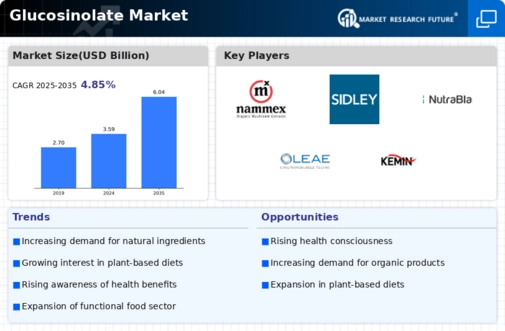Market Growth Projections
The Global Glucosinolate Market Industry is projected to experience substantial growth over the next decade. With a market value anticipated to reach 6.04 USD Billion by 2035, the industry is poised for expansion driven by various factors, including increased consumer awareness and demand for health-related products. The projected CAGR of 4.84% from 2025 to 2035 indicates a robust growth trajectory, suggesting that glucosinolates will play an increasingly vital role in the health and wellness sector.
Growth in Functional Foods
The Global Glucosinolate Market Industry is witnessing a notable expansion in the functional foods sector. As consumers increasingly prioritize health and wellness, food manufacturers are incorporating glucosinolates into various products. This trend is evident in the rising popularity of fortified foods that promote health benefits, such as improved digestion and enhanced immune function. The market's growth trajectory suggests it could reach 6.04 USD Billion by 2035, indicating a robust interest in functional foods that leverage the health-promoting properties of glucosinolates.
Increased Research and Development
The Global Glucosinolate Market Industry benefits from heightened research and development efforts aimed at exploring the diverse applications of glucosinolates. Scientific studies continue to unveil the potential health benefits of these compounds, which may include anti-inflammatory and antioxidant properties. This ongoing research is likely to stimulate innovation in product development, leading to new applications in pharmaceuticals and nutraceuticals. As a result, the market is expected to grow at a CAGR of 4.84% from 2025 to 2035, reflecting the increasing interest in glucosinolates as a functional ingredient.
Rising Demand for Health Supplements
The Global Glucosinolate Market Industry is experiencing a surge in demand for health supplements, driven by an increasing awareness of the health benefits associated with glucosinolates. These compounds, found in cruciferous vegetables, are recognized for their potential anti-cancer properties and overall health benefits. As consumers become more health-conscious, the market is projected to reach 3.59 USD Billion in 2024. This trend is likely to continue, as the global population seeks natural alternatives to synthetic supplements, thereby expanding the market further.
Consumer Preference for Organic Products
The Global Glucosinolate Market Industry is significantly impacted by the growing consumer preference for organic products. As more individuals seek organic food options, the demand for glucosinolate-rich vegetables, such as broccoli and kale, is on the rise. This trend reflects a broader movement towards sustainable agriculture and healthier eating habits. The increasing availability of organic produce is likely to drive market growth, as consumers associate organic products with higher nutritional value and health benefits, thereby enhancing the appeal of glucosinolates in the marketplace.
Regulatory Support for Natural Ingredients
The Global Glucosinolate Market Industry is positively influenced by regulatory support for natural ingredients in food and supplements. Governments worldwide are promoting the use of natural compounds due to their perceived safety and health benefits. This regulatory environment encourages manufacturers to explore glucosinolates as viable ingredients in their products. As regulations continue to favor natural over synthetic alternatives, the market is likely to see sustained growth, aligning with consumer preferences for clean-label products that emphasize health and wellness.







